A guide for how to represent yourself in the Trial Division of the Supreme Court of Victoria when you request a judicial review.

A judicial review is when a judge reviews a decision made by a Victorian lower court, tribunal, public official or body (for example, a local council, minister or public servant).
Judicial reviews are heard in the Trial Division of the Supreme Court. The review examines whether the person who made the decision:
- had the power (was allowed) to make the decision
- obeyed all aspects of the law in making the decision
- considered everything that was legally relevant.
A judicial review does not re-consider the facts of the matter or focus on whether the decision was correct.
A guide to requesting a judicial review
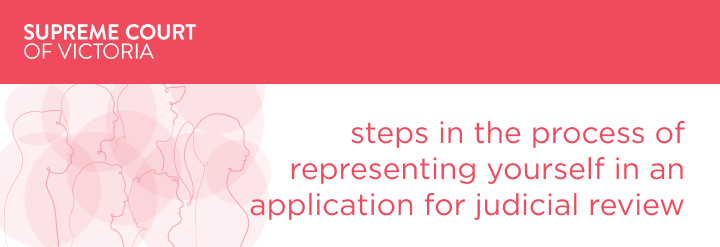
The information provided here is for people representing themselves in an application for judicial review. It includes what to do at each step, what forms you need to complete, what documents you need to provide, court fees and costs that apply and what it means to represent yourself in the Supreme Court.
Our one-page overview summarises the steps in the process for representing yourself in an application for judicial review in the Supreme Court. Further detail of what is involved is provided below.
You can also download a printable guide at the bottom of the page.
What is a judicial review?
A judicial review is when a judge reviews a decision made by a Victorian lower court, tribunal, public official or body (for example: a local council, minister or public servant).
A judicial review does not re-consider the facts of the matter or focus on whether the decision was correct.
The Trial Division hears judicial reviews.
When to request a judicial review
You might ask for a judicial review if you believe there has been a:
- breach of natural justice: did the decision maker follow the rules? For example, did they act fairly or allow everyone involved (all the parties) to present their side of the dispute?
- error of law: did the decision maker make a legal mistake? For example, did they misunderstand the law or apply it incorrectly?
- failure to take into account something that is relevant: the governing Act (law) often gives the relevant factors the court or tribunal must consider when making their decision.
Time limits
There is a time limit on applying for a judicial review.
You have 60 days, from the date the decision was made, to file an:
- originating motion for judicial review (Form 5G), and
- affidavit.
If 60 days have passed, you need to apply for the Court’s permission to extend the time limit.
To do this, file an originating motion and affidavit (see Step 1 for details). Explain in the affidavit why you are applying late and any special circumstances you want the Court to consider.
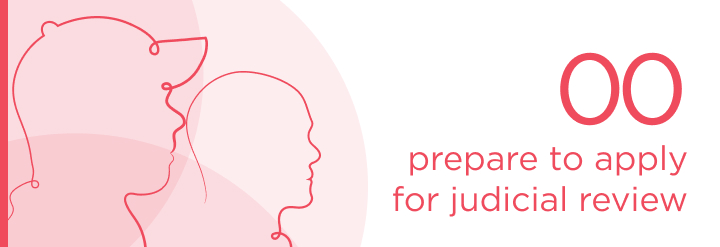
Consider the cost
Try to resolve the issue without involving the justice system.
Legal proceedings in the Supreme Court can be very expensive. Going to court should be a last resort.
You may need to pay court fees at different stages unless you have a fee waiver. There are no court fees if your review has arisen from a criminal proceeding.
If you lose your case, you may need to pay some or all of the other party’s costs. This includes what they spent on lawyers and any other expenses, such as the cost of expert reports.
Be aware – these costs can be substantial.
Get help from organisations that provide legal information and free or low-cost legal services.
Consider paying for some legal advice even if it is only to help with a particular part of the process. For example, it is highly recommended that a lawyer helps you work out the ‘grounds’ for your originating motion. These are the legal reasons or arguments you say prove your judicial review should be successful.
Get to know Court procedures
Read the following documents carefully. They provide important information and guidance:
- Steps in the process of representing yourself in an application for judicial review in the supreme court
- Supreme Court (General Civil Procedure) Rules 2015 – specifically order 56
- Practice Note SC CL 9 – Judicial Review and Appeals List
- Practice Note SC Gen 7 – Transcript in Civil Proceedings.
Get to know your obligations
As a party in a civil proceeding, you need to understand what’s known as overarching obligations. See sections 16-26 of the Civil Procedure Act 2010.
Do your legal research
Make sure you understand the law that applies to your case by doing some legal research.
Read about cases similar to yours, and note any cases where the law you are relying on has been applied in a way that you think proves your arguments.
Create a RedCrest account
You file documents with the Court using the online system RedCrest.
For instructions on how to set up a RedCrest account, visit our Videos page.
The RedCrest Electronic Filing User Guide has further information and instructions.
Check if you need to order a transcript
A transcript must be arranged by the parties and paid for in advance for all final hearings and sometimes for other hearings.
Read Practice Note SC Gen 7 (Transcript in Civil Proceedings) to know when and how to get the transcript.
Get to know legal terms
Check the glossary for common legal words and terms.
Know how to stop your judicial review
You can stop your judicial review if you have the consent of all parties or permission from the Court.
Be aware that if you stop, you usually need to pay the defendant’s costs up to that point, unless:
- you and the defendant agree you do not have to pay their costs, or
- the Court orders that you do not have to pay their costs
To stop your application, complete a Notice of Discontinuance form stating that you are discontinuing your appeal and sign it. Ask the defendant to sign too, to show they agree. Then file the form in RedCrest and wait for RedCrest to advise that a sealed copy is available. Download and print the sealed copy and serve it on the defendant.
If the defendant will not sign the form, you must get the Court’s permission to stop your judicial review. Contact the Self-represented Litigant Coordinator to discuss your situation.
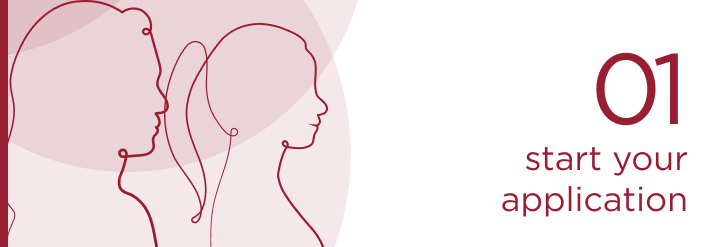
File an originating motion, affidavit and certifications
To start your application, file:
- Originating motion for judicial review (Form 5G)
- Affidavit
- Proper Basis Certification
- Overarching Obligations Certification.
Pay the commencement fee or apply for a fee waiver.
You must file these documents within 60 days of the decision you want reviewed.
If you are filing later, state in your affidavit the reasons why the Court should give you permission to apply late.
You can file your additional documents at the same time, if you have them ready (see below).
Originating motion
Your originating motion (Form 5G) must include:
- what you want the Court to do about the original decision, for example, to declare it invalid
- why you think the original decision maker did not properly comply with the law in making the decision.
Affidavit
Your affidavit sets out the facts and circumstances that you will rely on to support your judicial review.
Attach to the affidavit as an exhibit:
- a copy of the order or decision that is the focus of the judicial review. Sometimes this is a letter or other official document from a Victorian minister, council or other government body.
- any written reasons that were prepared in relation to the decision or order.
Complete a Certificate Identifying Exhibit (Form 43) for the exhibit.
Any affidavit that is filed with the Court must:
include a maximum of one exhibit. If more than one document is referred to in the affidavit, the documents must be combined into a single ‘bundle exhibit’, ordered in the sequence they are referred to in the affidavit;
If you do not have the original order and written reasons, explain in the affidavit why you were unable to get them.
Get a date for your directions hearing
You must get a date for your directions hearing before you can file your additional documents.
Do not delay starting this step. You must file your additional documents within seven days of filing your originating motion, affidavit and certifications.
To get a date for your directions hearing:
- complete a Judicial Review and Appeals List hearing date information form
- complete a draft Summons (Form 46A)
- Email both documents to whqvpvnyerivrj@fhcpbheg.ivp.tbi.nhua.vog.civ.truocpus@weiverlaiciduj
- Check your email for a Supreme Court notice advising the date.
File additional documents
No later than seven days after filing the originating motion, affidavit and certifications, you must file:
- a completed Summons, which includes the date for the directions hearing
- the Supreme Court notice advising the date for the directions hearing.
When your documents are accepted
After you file your documents, the Court will check them and advise if you need to make any changes.
You will be notified when your documents have been accepted and no other changes are needed.
Once accepted, the documents will have the Court’s seal on them.
Step 1 checklist
- File originating motion, affidavit and certifications
- Pay the commencement fee or apply for a fee waiver
- Get a date for your directions hearing
- File your Summons and Supreme Court notice that advises the date for the directions hearing
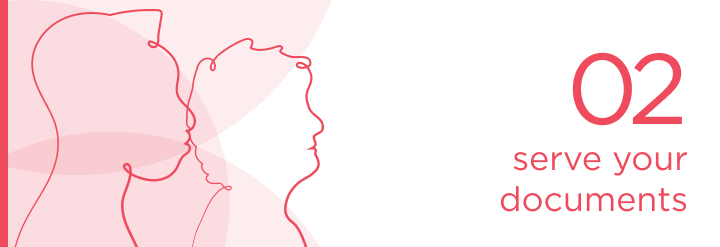
Who to serve
You serve your documents on the defendant, or on each defendant if there is more than one.
You also serve your originating motion on the decision-making body that made the original decision. This is how you officially advise them that you are requesting a review of their decision.
What documents to serve
Serve the documents that have the Court’s seal on them. These include the:
- Originating motion
- Affidavit, including the order and any written reasons prepared in relation to the order
- Summons.
When to serve documents
Serve the documents as soon as possible after being notified that your documents were accepted.
The Court cannot progress your case if your documents are not served before the directions hearing.
How to serve documents
You must serve the originating motion in person. This means that you, or someone else on your behalf, must:
- leave a copy of the document with the person to be served, or
- if the person does not accept the copy, put it down near them and tell them the nature of the document.
You are allowed to serve the additional documents by email or post. However, people usually serve all the documents at the same time and in person.
Step 2 checklist
- Serve your documents on the defendant
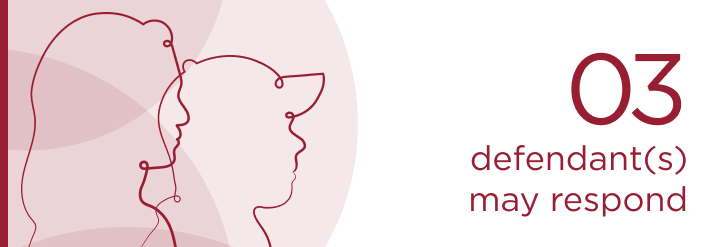
Once the defendant gets the documents, they may do nothing or they may respond in a number of ways.
For example, the defendant may:
- file a Notice of Appearance and serve it on you, before the directions hearing. This is how a defendant lets you and the Court know they want to be involved in the proceeding.
- make an application to the Court of their own, at any time leading up to the final hearing. There are many different types of applications the defendant can make. You can read about them in the Supreme Court (General Civil Procedure) Rules 2015 and the relevant law.
The defendant must serve on you any documents they file with the Court.
Step 3 checklist
The defendant may file documents with the Court and serve them on you
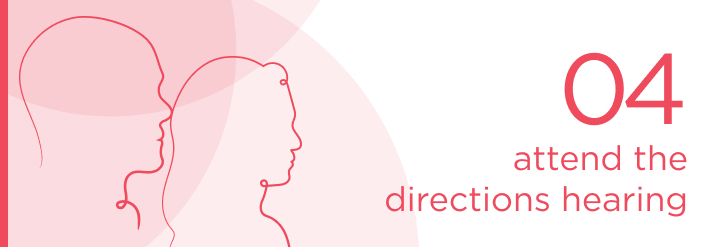
About the directions hearing
A directions hearing is a short hearing to decide matters related to the timing of when things happen during the proceeding. This includes what has to happen, who does it and when it needs to be done.
The directions hearing is not when you present your arguments to the Court. This happens at the trial.
If a directions hearing is scheduled, the Court expects the plaintiff and defendant to attend.
If you cannot attend for any substantial reason, for example if you have a medical emergency, contact the Court immediately.
What to bring to the directions hearing
Bring the documents you filed in Step 1, something to make notes on such as a notepad, tablet or laptop and your diary (so you can check if dates proposed are suitable).
After the directions hearing
After the directions hearing, the Court will send you a formal copy of the Court’s orders. The orders say what you and the other parties need to do to prepare for the trial.
Step 4 checklist
- Attend the directions hearing
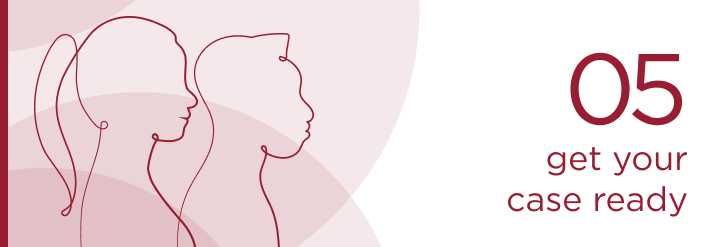
Follow the Court’s instructions
The orders made at the directions hearing will tell you what you have to do to get your case ready for the judge. This includes which documents to prepare and when they need to be filed with the Court.
Some things you may need to prepare include:
- List of authorities – a list of the cases, legislation and secondary sources such as textbooks and journal articles that you say support your case.
- Outline of submissions – your outline of submissions draws together your facts of the case, what happened in the original decision or court proceeding, the law that applies (legislation and cases) and your explanation of why you believe there was an error. Arrange the different sections under headings and number each paragraph as you go. You can expand on some or all of these points at the hearing.
- Affidavit (in addition to the affidavit you filed in Step 1) – any additional evidence you want the Court to consider, which was not contained in your original affidavit.
- electronic Court book – prepare digital copies of all the documents you and the defendant intend to rely on during the hearing.
- Your response to the defendant’s submissions – you have the opportunity to respond to the defendant’s submissions, if they prepared these and served them on you in response to the documents you served on them in Step 2.
Prepare to present at your hearing
To help prepare for your hearing, watch our videos:
Preparing for a hearing
For more videos, and to view a transcript of this video, visit the Videos to help with Court processes page.
Attending Court – the day of your hearing
For more videos, and to view a transcript of this video, visit the Videos to help with Court processes page.
Include in your outline of submissions all the important points you want the judge to consider. The more clear and complete your outline of submissions, the less you will need to explain them in the hearing.
Step 5 checklist
- Follow the Court’s instructions about what documents to prepare and when to have them ready
- Prepare for your hearing and know what to expect by watching the Court’s videos, available on our website
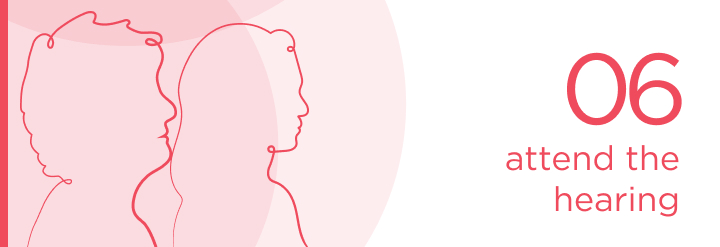
Finding out your hearing date
The date for the final hearing is usually decided at the directions hearing you attended in Step 4. The Court will send you an order that confirms the date.
Judicial reviews do not usually involve the calling of witnesses but will focus on the documents filed by both parties. The plaintiff will usually be given the opportunity to explain their case to the judge first, followed by the defendant. The plaintiff is usually given a right of reply to what the defendant says.
What to expect at the hearing
To help understand what to expect at the hearing, including what to bring with you, how to address the judge, where to sit and what you will need to do, see the Court’s video Attending Court – the day of your hearing.
The hearing date is usually 6-9 months after the directions hearing, except in urgent cases. This gives all parties enough time to properly prepare their case.
Step 6 checklist
- Attend the final hearing
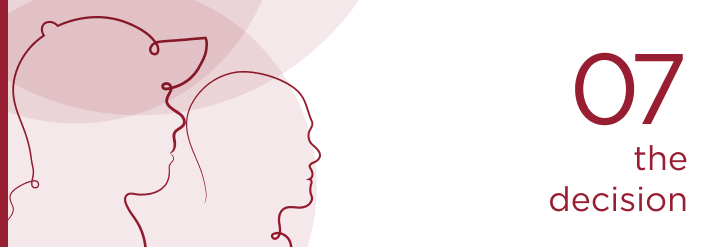
When to expect the decision
The judge usually reserves their decision (judgment). This means they do not give a judgment on the day of the hearing but at a later date. This gives the judge time to consider both parties’ submissions and write reasons for their decision.
You can expect a decision within weeks or months of the final hearing, depending on the complexity of the case.
Finding out the decision
The Court will email you a date and time when you need to return to Court to get the judge’s decision. This is called the handing down of the decision.
Plaintiffs and defendants are expected to attend. However, if you do not attend the Court will email you the decision.
At the handing down of the decision, if you do not succeed in your application for judicial review, the Court may order you to pay the defendant’s costs. If you win, the Court may order the defendant to pay your costs, if you had any.
If you are successful in your judicial review
At the end of the judicial review, the judge may decide that the person who made the initial decision did not:
- have the power to (was not allowed to) make that decision
- obey all aspects of the law in making the decision, or
- consider everything that was legally relevant.
If the judge decides that any of the above apply, they may:
- cancel the original decision (quash the decision), or
- order the original decision maker to consider the decision afresh or rehear the case (if the decision maker was a court or tribunal).
If you are not successful
If you are not successful in your proceeding, you can apply for leave to appeal (permission from the Court) to appeal the decision in the Court of Appeal.
See our guide Representing yourself in a Court of Appeal civil proceeding.
Step 7 checklist
- Return to Court to receive the decision
- Know your options if your proceeding is not successful
If you require further guidance contact the Self-Represented Litigant Coordinator.
